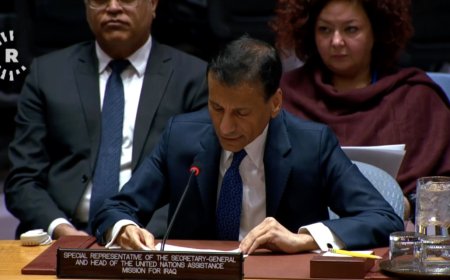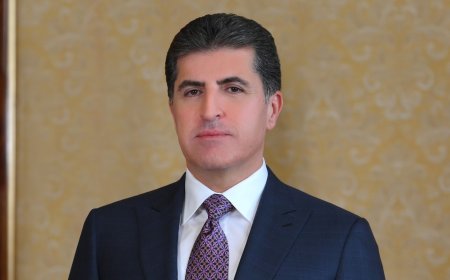What Comes After Starvation in Gaza?
For the severely malnourished, simply starting to eat normal meals again can cause sickness—even death.

A few weeks ago, Soliman Zyad, a young health-care worker in northern Gaza, told me that his family was near starvation. On some days, he and his uncle AbdulKareem walked in search of food from 3 a.m. until the afternoon. “We swore we would not return home without finding flour,” Zyad told me. “People were ready to risk their lives for a single sack.” Almost forty per cent of the population was going days at a time without eating, according to the World Health Organization. Sometimes AbdulKareem would vomit from hunger and fatigue. His wife, pregnant with twins, was severely anemic.
The latest food shortage in Gaza began in March, when Israel ended a ceasefire and imposed a blockade on all aid that lasted eleven weeks. After that, the Gaza Humanitarian Foundation, which was backed by Israel and the U.S., began distributing limited amounts of aid; around three thousand Palestinians were killed while seeking food. This month, a United Nations study published in The Lancet reported that more than fifty-four thousand children are malnourished in Gaza. “Every family, by now, has been affected,” John Kahler, a pediatrician and a co-founder of MedGlobal, a humanitarian organization that operates in Gaza, told me. About one in five babies was born premature or underweight. MedGlobal cared for one infant, Rafeef, who weighed just four pounds at birth. Her mother was too malnourished to breast-feed; the baby cried constantly, began losing weight, and developed ulcers and infections. On August 18th, she died.
“We live day by day,” Eyad Amawi, a father of four who works as an aid coördinator in Gaza, told me in September. “We have just enough to survive, but not enough to carry out our normal activities.” On the black market, the price of a kilogram of flour—about ten cents before October 7, 2023—had risen to thirty-five dollars, when it could be found at all. Amawi often saw malnourished children who lacked the strength to play. He worried that months of famine had already inflicted irreversible damage. “We are losing the next generation,” he said. “They will suffer for all their lives from this.”
Now that a ceasefire is in place, aid is trickling in. Under the terms of the ceasefire agreement, six hundred trucks a day are meant to enter Gaza. The United Nations Relief and Works Agency for Palestine Refugees in the Near East reports that it has stockpiled three months of food for everyone in the territory. There is reason to hope that, for all the lasting destruction in Gaza, the immediate crisis of hunger will come to an end. “As this famine is entirely man-made, it can be halted and reversed,” the Famine Review Committee, an international body that monitors food insecurity worldwide, wrote in August.
Yet numerous experts warned that not all consequences of famine can be undone. “People don’t realize that one doesn’t just recover from starvation,” Dana Simmons, a historian and the author of “On Hunger: Violence and Craving in America, from Starvation to Ozempic,” said. For the severely malnourished, simply starting to eat normal meals again can cause sickness—even death. And survivors of starvation are at risk of chronic diseases and mental-health conditions for decades after they regain access to food. “You’ve stunted a generation,” Nathaniel Raymond, the director of the Humanitarian Research Lab at Yale, told me. Ruth Gibson, a scholar at Stanford’s Center for Innovation in Global Health, spoke in even starker terms. “Can this be reversed?” she said. “The answer is, it can’t be.”
Much of what we know about the toll of starvation comes from the Warsaw Ghetto, where the Nazis forcibly resettled about half a million Jews starting in 1940. German authorities in occupied Poland restricted provisions to “less than the minimum to preserve life”; a ration card from October, 1941, allotted most Jews roughly three hundred daily calories. Deaths eventually climbed to five hundred per day. Under these horrific conditions, twenty-eight Jewish doctors who had been sent to the Ghetto, led by a dermatologist named Izrael Milejkowski, recruited seventy adults and forty children for research into what they called pure starvation, meaning that those afflicted had no additional infections or diseases. As the physician Leonard Tushnet wrote, in 1966, the researchers—who were themselves going hungry—conducted “an exhaustive and precise study of the effects of starvation.” The study continued until deportations to the Treblinka extermination camp, where many of the researchers would ultimately perish, began, in 1942. They hurriedly compiled their charts and graphs into a manuscript, which was then buried in a steel jar. It was recovered after the war and published, in Polish, in 1946.
In the forties, exactly how the body dealt with starvation remained a mystery. The doctors used equipment that had been smuggled into the Ghetto to measure capillary circulation, examine bone marrow under microscopes, and record electrocardiograms. The quality of their scientific work was “amazing,” Merry Fitzpatrick, a scholar of malnutrition and famine at Tufts University, told me. They wrote that muscle melted away, skin acquired the texture of cigarette paper, and swelling often afflicted the legs, scrotum, labia, heart, and lungs. In a cemetery shed, the doctors performed more than three thousand autopsies, which revealed that starvation softened the bones and atrophied vital organs. Starving children stopped playing and appeared sluggish or apathetic; cognitive development seemed to halt or even regress. Some looked like “skin-covered skeletons.”
One of the study’s most important findings was that the body has sophisticated ways of saving energy and sparing critical tissues and functions. Reserves of glucose in the blood, liver, and muscle quickly run low. Then the body shifts to burning fat in three different ways. Some of the fat molecules can be used to create glucose; some can be used to create ketones, an alternative energy source for certain tissues, including the brain; and some can be directly broken down inside the mitochondria to create adenosine triphosphate, or ATP, the primary energy source for our cells.
The human body’s strategies for conserving energy have something in common with how bears enter hibernation. By measuring the amount of carbon dioxide in the breath, the Warsaw researchers determined that metabolic rates decreased by as much as forty per cent; heart rates, blood pressure, and core temperature fell. But these adaptations can buy only so much time. Eventually, the body turns to an energy source of last resort: the amino acids in proteins, which can be stripped down chemically and burned to create ATP. “The body will cannibalize itself to meet those needs,” Fitzpatrick said. This explained the atrophied organs. It’s as if the body were a cabin in the woods and starvation were a terrible winter. You can burn boards from the walls, but at some point the cabin no longer offers any shelter. “The goal is to keep you alive, in a suboptimal way—to get you to the point where you can have adequate nutrition again,” Joshua da Silva, an emergency physician with expertise in malnutrition, told me.
If that point never arrives, then starvation enters a terminal stage—one that scientists have seldom documented in humans. Milejkowski and his colleagues found that emaciated children had no antibodies against tuberculosis. They were so susceptible to infections that a routine urinary-tract infection could become deadly. Those who were spared infections tended to die when the heart failed—in the words of the Warsaw doctors, “like a lamp that has run out of oil.”
Under normal circumstances, a scientific study of starvation could never be conducted today. “You’re not going to let someone starve to death, just to see what happens,” Fitzpatrick told me. But, in 1944, when the field of medical ethics was still developing, Ancel Keys, a physiologist at the University of Minnesota, recruited thirty-six male conscientious objectors to voluntarily starve themselves. During a three-month period, their caloric intake was whittled away until they lost a quarter of their body weight. One man became so weak that he couldn’t push a rotating door in a department store; another was removed from the study for eating scraps from a garbage can.
Keys confirmed the cardiovascular and metabolic changes recorded in Warsaw but also documented psychological consequences that had not been reported before. Volunteers became depressed, irritable, anxious, and withdrawn. They struggled with concentration and problem-solving. “They developed an almost pornographic obsession with food,” Todd Tucker, the author of “The Great Starvation Experiment,” told me. The St. Paul Dispatch reported that the men “lost so much physically and mentally that their ambition is gone, their will to go forward is gone.” Some developed symptoms of psychosis; one person amputated three fingers with an axe. The daughter of a man who participated said that her father kept canned food under his bed for the rest of his life. Wendy Spettigue, a professor of psychiatry at the University of Ottawa, said that these effects are typical of starvation. In July, she and her colleagues published a review of more than a hundred studies evaluating the psychological, cognitive, and behavioral effects of starvation. “We found that starved brains cannot be happy brains,” she told me. The consequences for patients who endured famine often lingered long after the hunger ended.
Another surprise was that, when Keys allowed volunteers to start eating again, their condition worsened. This effect had occasionally cropped up in the historical record: Flavius Josephus wrote about it in the year 70, after the Romans besieged Jerusalem, and a Florentine physician observed it during a 1496 famine. The Warsaw doctors likewise wrote about patients whose hearts failed after they were fed; when Allied soldiers liberated the concentration camps, large numbers of emaciated people died after being given high-calorie foods such as chocolate. “Why, when you are starving, would food cause your death?” Alison Culkin, a consultant dietician at St. Mark’s Hospital in London, said. “It was counterintuitive.”
The phenomenon became known as refeeding syndrome. Its exact cause wasn’t discovered until the eighties. Da Silva explained that, during chronic starvation, the body tries to adapt to very low levels of insulin, vitamins, and minerals. “Refeeding syndrome comes from the sudden restoration of all of your calories, all at once,” he said. “Your metabolism can’t switch back fast enough.” Too much insulin is produced, which causes a spike in carbohydrate metabolism, and phosphate, potassium, and thiamine flow out of the blood and into cells. Low levels of phosphate and potassium in the blood can cause cardiac and respiratory arrest; low levels of thiamine can damage the brain. “Every organ is affected,” Culkin said.
I asked da Silva whether Gazans who suddenly regain access to food will be at risk of refeeding syndrome. “How could they not?” he said. Kahler, the MedGlobal pediatrician, was gravely concerned. “Kids could die,” he said. “They’ll refeed them, their insulin will pour out, and they could die.” The best way to prevent refeeding syndrome, my sources said, is for health-care workers to intensively monitor high-risk groups, which include people who have lost a lot of muscle or fat, or who have eaten less than half of what they need for a month or more. According to the American Society for Parenteral and Enteral Nutrition, medical professionals should perform blood tests on anyone in these categories, first before they eat and again every twelve hours for the first three days. Oral rehydration salts or an I.V. drip can bolster electrolytes. Vital signs should be checked every four hours for the first day. Feeding should start at very low levels, beginning with a hundred grams of liquid glucose—the equivalent of half a cup of sugar. But all of this will be extremely difficult in a place where most health-care facilities are in ruins.
For those who lack access to medical supervision, Kahler said, the safest course is to proceed with an agonizing level of caution. He recommended small portions of food, five to six times a day, for the first two days; a person who does well can start eating progressively larger portions over the span of a week. In unmonitored settings, he said, sugar-rich foods such as candy and soda should be avoided in favor of beans, lentils, eggs, bananas, and greens. Multivitamins, oral rehydration salts, and electrolyte supplements can help, if available. He listed warning signs that call for immediate medical attention: severe fatigue, swelling in the legs or face, irregular heartbeat or breathing, vomiting or diarrhea, and cramps or seizures. “Even though every fiber of your being wants to give your child all she has been deprived, don’t,” Kahler wrote to me. “Be patient.”
It’s tempting to think about hunger as a temporary state, something that exists only until food can be accessed again. In the decades after the Second World War, however, studies began to suggest that its effects can be permanent. Scientists realized that the Netherlands—the site of a 1944 railroad strike in support of the Allies, followed by a retaliatory Nazi blockade on food—had kept meticulous records of a subsequent famine, the Dutch Hunger Winter. “Scientifically, it’s a treasure trove,” Bas Heijmans, a biologist at Leiden University, told me. “It’s as close as you can get to an actual experiment.” Researchers knew where and when people were born, how much food they were given, and what had become of them. Those born in unaffected areas, or siblings born before or after the famine, could serve as a control group.
Since the nineties, a number of studies have examined the long-term impacts of starvation on fetuses in the womb. “These effects are measurable eighty years later,” Tessa Roseboom, a biologist at the University of Amsterdam who has been studying the Hunger Winter for thirty years, told me. People who were gestating during the famine grew up to have smaller brains; their kidneys had fewer nephrons, which reduces the organs’ effectiveness. “Cognitive function is different, mental health is different, changes in metabolism led to increased rates of Type 2 diabetes,” Rosebloom said. She has documented increased rates of depression, anxiety, and addiction. “There’s only one time in your life when you’re building all your organs,” she said. “There’s no second chance to build your heart or your brain again.” Other scientists have linked prenatal starvation with schizophrenia, lower I.Q., reduced economic participation, and increased mortality. Exposure to starvation in this way, Heijmans said, “casts a shadow across the rest of your life.”
Daniel Ramirez, a demographer and research associate at Penn State, used a similar study design to measure the impact of starvation on those who were children during the famine. “I found effects for education, income, occupation, functional limitations, depression,” he said. Children who had survived starvation ultimately completed fewer years of education, had a lower chance of attending college, and were twenty per cent more likely to fall below the poverty line. “The body has memory,” Ramirez told me.
In 2018, Heijmans and L. H. Lumey, an epidemiologist at Columbia University, published a paper showing that the famine had altered the expression of genes associated with growth and metabolism. In times of scarcity, these changes could help a person survive, but after the famine they seemed to contribute to chronic diseases such as diabetes. “If as a fetus there is scarcity, you are being programmed to deal with it,” Heijmans said. “We see the effects of this tragedy on the DNA sixty years later.”
The last time Gaza experienced a ceasefire, early this year, I was there, as part of an international team of health-care workers. Hunger was widespread but nowhere near as extreme as it would become. Within days, tables were lining the sidewalks of Khan Younis and Gaza City, piled high with avocados, oranges, and even fresh chicken. In the span of several weeks, ten thousand aid trucks entered Gaza. The devastation was so severe that rebuilding and recovery seemed years away. Now, after a declaration of famine and seven more months of Israeli strikes, recovery will be even more difficult. Amawi, the aid coördinator, told me in a text message that some supplies began to enter Gaza this week, but it wasn’t enough. (A United Nations tracker reported that, in recent days, fewer than a hundred trucks, on average, have been reaching destinations in Gaza daily.) His family still depended on whatever flour and limited canned goods could be found in the markets. Fresh foods such as meat, eggs, and produce remained inaccessible. “There has been no real improvement in the nutritional or health situation,” he wrote. Malnourished children have continued to arrive in pediatric wards, he said. He added that his four-year-old son “doesn’t know the names of fruits and vegetables—he’s never seen them before.”
Amawi worried about the risk of refeeding syndrome. “In reality, implementing a gradual refeeding program in Gaza is very difficult right now, because hospitals are operating with extremely limited capacity,” he wrote. “Many lack medical staff, essential supplies, and even the special therapeutic foods needed for cases of malnutrition.” He didn’t think that doctors and humanitarian workers would be able to follow recommended protocols; they need large numbers of outside health-care workers, cardiac monitors, I.V. kits, and hospital beds. “As for ordinary people, most are unaware of the risk of refeeding syndrome,” he told me. “They will just provide whatever food is available to ease the hunger, even if it’s not nutritionally ideal.”
The Dutch famine lasted less than six months, but its effects are still felt today. “We’re on the road for the same kind of thing in Gaza, or worse,” Ramirez told me. “It’s extremely likely that we will see higher levels of obesity, heart disease, mental illness, and socioeconomic consequences.” Children make up half of Gaza’s population. “They will suffer the consequences their whole life,” Heijmans said. How do you begin to mitigate such far-reaching effects? Gazans will need not only nutritious food but also teachers and schools, therapists and clinics, doctors and hospitals, homes and jobs. Everything, in short, that the war has taken from them.
[Source: The New Yorker]




















/file/attachments/orphans/1000146612_845134.jpg)

































